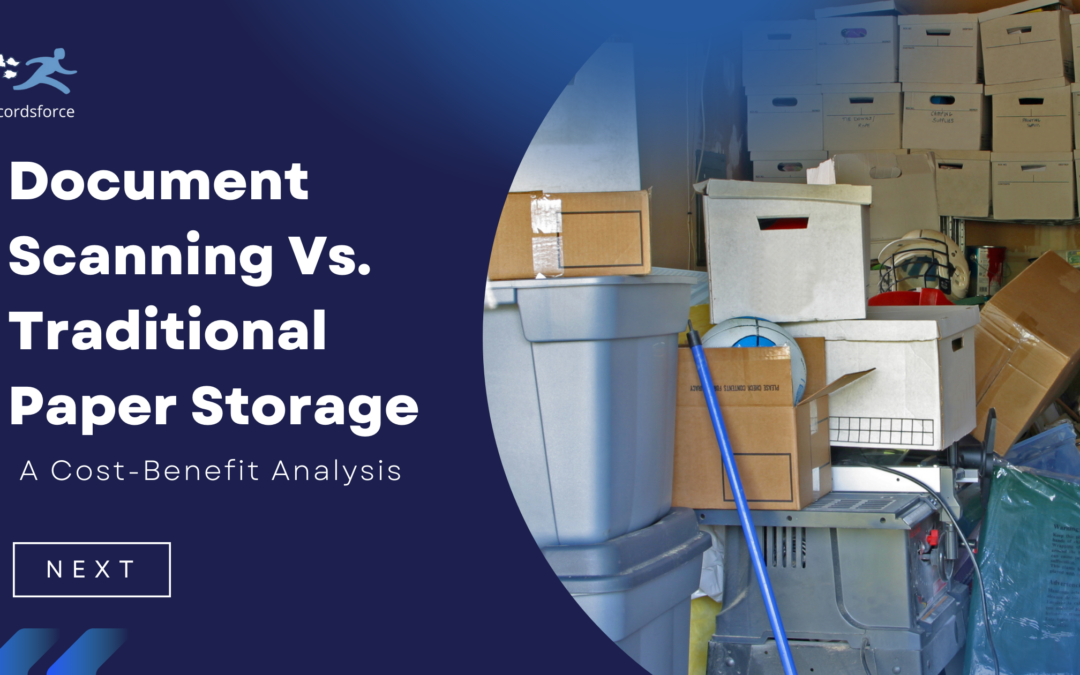Businesses are constantly confronted with the decision of whether to embrace document scanning and go paperless, or continue with the traditional and legacy methods of paper document storage and processes. This choice involves a careful evaluation of the financial implications associated with both approaches. While there are upfront costs and operational adjustments involved in transitioning to a digital system, the long-term benefits often outweigh these initial investments. Let’s break down the financial aspects of both document scanning and traditional paper storage to better understand their cost-benefit dynamics.
Traditional Paper Storage
Upfront Costs:
- Storage equipment and space: The need for filing cabinets, shelves, and physical storage space incurs initial expenses.
- Supplies: Ongoing costs for paper, ink, toner, folders, and other stationery items add up over time.
- Maintenance: Regular maintenance and storage space can accrue unexpected expenses.
Operational Costs:
- Time-consuming retrieval: Manually searching for documents leads to increased labor costs.
- Security risks: Higher vulnerability to loss, damage, or theft of physical documents may result in additional costs for security measures or recovery.
- Environmental impact: Over time, the environmental costs related to paper production and disposal can be substantial.
Document Scanning and Paperless Storage
Upfront Costs:
- Outsourced scanning provider: Investing in scanners, software licenses, and potentially hiring and training employees for the transition only adds more to your costs. A document scanning provider has everything needed to make an easy and smooth transformation to a paperless office.
Operational Costs:
- Digital storage solutions: Cloud storage or digital document management and workflow integration systems tend to have a monthly cost associated, but increase efficiency and security over your documents.
Long-Term Benefits:
- Reduced physical storage costs: Savings on physical space, maintenance, and supplies.
- Improved accessibility and efficiency: Quick document retrieval and streamlined workflows can lead to increased productivity and cost savings in the long run.
- Enhanced security: Digital encryption, access controls, and backup systems mitigate risks associated with physical document storage.
Cost Benefit Analysis:
Traditional Paper Storage:
- Pros: Familiarity, minimal initial investment
- Cons: Long-term costs accumulate, increased risk, and reduced efficiency.
Document Scanning and Paperless Storage:
- Pros: Long-term cost savings, improved efficiency, enhanced security.
- Cons: Initial investment, adaptation period.
While the shift from traditional paper storage to a digital document management system involves upfront costs and operational adjustments, the long-term financial benefits are substantial. Cost savings in physical storage, reduced operational expenses, improved accessibility, and heightened security outweigh the initial investments in transitioning to a paperless system. Businesses must carefully evaluate their specific needs, considering the long-term financial gains and operational efficiencies that come with embracing document scanning and paperless storage in today’s digital age.
Ultimately, the decision between document scanning and traditional paper storage should be made with a comprehensive understanding of the financial implications and the potential for increased efficiency and cost savings in the future.

